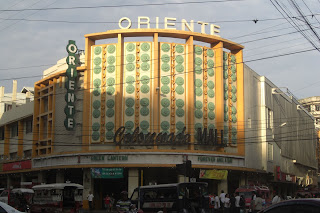First, a disclaimer:
This blog is suppose to promote Cebu as a travel destination. Well, this blog still is. But as one may read in this entry, I would have to be honest with what I could say about our latest subject, Colon. It's filthy. It's crowded. It's extremely pedestrian and reeks with pirated merchandise, not to mention street urchins, pimps and their wares. Hooligans and thugs are just some of the likely attractions. Ok, locals refer to it as a dangerous place, not so less at night. Colon, despite its historical significance, is hardly a tourist destination such as Shangri-La Mactan but, hey, I believe that there is always a market for anything and everything including obese ladies prancing in a peep show. No, they don't have that there. Wait... I will check.
 |
| Haggle or get snatched? Whichever comes first, pick your attraction. |
Every time a photographer/friend/lawyer/college classmate comes to Cebu for a hearing, he invites me to stay with him in his hotel so I could help art direct his photo shoot. Yes, he always stay in a hotel right at the heart of Colon. At night, the street lights were off save for the hotel's front, grizzly shadows lurk the side walks, taxis were afraid to stop... get the picture. I would not be surprised to see tires burn incessantly in the middle of the street and homeless people warming their palms by a fire from a trash can. Robocop patrolling.
Seriously, one may ask, "Why the damp?" Urban ecologists and theorists would be out of job if I have the answer. |
So why go to Colon? Again, for a culture vulture (the sociologist kind, not the pretentious snobs frequenting Republique in Pasay and what-used-to-be Embassy in The Fort), Colon is a melting pot of so many curiosities, though not for the squeamish. First, one cannot claim to have toured Cebu without a visit to the Sto. Nino Shrine, and this Cebuano's most sacred of places is smacked right at Colon's periphery. Then there's, of course, the gamut of cheap merchandises you'd be happy pirates exist in this world. While looking for prepaid load for my cellphone, I ended up in an electronics shop. There I found some fancy speakers that's worth Php6,500 at a local Mac store. These are sold for only around Php1,500 and still could be haggled with. But I dared not buy a second hand.
 |
| Rich countries spent billions to find life in outer space. Aren't we glad we have such thriving organisms in Colon that other planets lack? |
Lately, I have developed a new vice - HD DVD in cute tin can packaging! Hehehhehe... And in one of my trips to Colon to satisfy my craving for fancy HD DVD packaging (not for the movies they contain), I noticed the facades of some of Colon's edifices, particularly one where I buy my DVD (again, I insist, for the packaging). Man, Carlos Celdran should put up in Colon a branch of his city archi-tours!
Here is a treasure trove of architectural interests that could only be considered a blast from Cebu's glorious past, rivaled only by Manila. Other than historical landmark Sto. Nino Shrine, here is Colon's offering of urban edifices that should keep a conservationist nervous. For tomorrow threatens this particular past.
Behold why I dare Colon in spite of the threats:
 |
| Art deco innovation: a finely lined edifice with columns that punctuate its facade, lending it a classic feature on an otherwise flat geometric surface. |
 |
| One sorry state for Colon's historical buildings. Another art deco edifice being sacrificed in the name of change. I love the signage of the mall. Reminiscent of American 50's burger joints. |
 |
| This modernist design must have been inspired by Zaragoza's Meralco headquarters in Ortigas. |
 |
| Architecture such as this makes me teary-eyed and prompts me to genuflect. That's because I am a fanatic of everything camp and art deco facades are always campy. |
Before I end, I must admit that my architectural appreciation of Colon has been both enkindled and blurred by my interest in HD DVD cute packagings. In fact, it is the ultimate reason. Suffice to say that the penultimate is still about architectures and facades, particularly one that follows:
Please, don't be gullible. I beg you.






